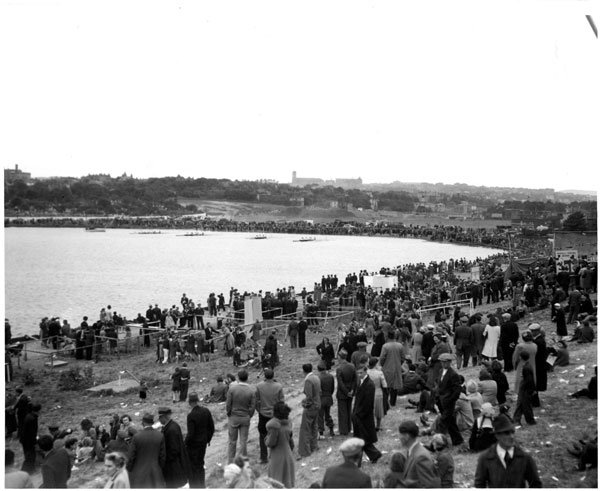8-Inches of Ice… in August
The Signal Hill gun echoed across the city.
It was 9am, August 3rd, 1932 and the people of St. John’s knew exactly what it meant — the wind and weather were fine; the St. John’s Regatta on Quidi Vidi Lake was a ‘go’ — and so was the holiday that came along with it.
Quidi Vidi with races on Regatta Day, The Rooms Archive, copyright expired.
St. John’s Regatta
The Regatta had been running since at least 1818 and was always a highly anticipated event in the community — for the races and for the fair-like atmosphere that came with them. It was a lot of fun.
-
The Royal St. John’s Regatta is boat race held on Quid Vidi Lake on the first Wednesday of August (weather permitting). It is considered the oldest organized sporting event in North America. The first record of an organized regatta was in 1816, but rowing competitions were popular in St. John’s Harbour much earlier. With the exception of breaks during the World Wars, the Regatta has happened nearly every year since. It has received a federal designation as a National Historic Event and in 1993, the St. John’s Regatta became the “Royal St. John’s Regatta” having received the designation from Queen Elizabeth II.
It’s about more than just rowing. The shores of Quidi Vidi resemble a fairground during the Royal St. John’s Regatta with food, contests and music.
Even those who didn’t find themselves at the lake took advantage of the summer holiday to wander the city’s parks, picnic and swim.
St. John’s Regatta scene, circa 1930, The Rooms Archive, copyright expired.
Though the day started under clear skies, by noon a blanket of clouds had moved in and it had started raining.
Fortunately, for participants and spectators alike, it was a short-lived shower and spirits were barely dampened.
The skies cleared, and the day continued with beautiful weather.
They didn’t know how lucky they were.
Bay Bulls
Just outside the city, in Bay Bulls, the weather was much worse.
At about 1:30pm the sound of distant thunder could be heard. By 3pm a violent storm had erupted.
For half an hour heavy rain and hail pelted the community. Newspapers reported that visitors to Bay Bulls Long Pond had been caught in the deluge and were soaked to the skin — no big deal, but not a great way to spend what ought to have been a fun summer afternoon.
They didn’t know how lucky they were.
Hodgewater Line
As unpleasant as the storm in Bay Bulls was, it had been much worse further west on the Avalon Peninsula.
On the Hodgewater Line (aka Route 71) the rain had been preceded by a heavy bout of hail — the likes of which no one had seen before.
The hail, the newspapers said, “arrived with a roar as of continuous thunder.” Ice pellets the size of hazelnuts pummelled the area.
But the size of the ice wasn’t the issue — it was the sheer volume.
In the aftermath of the storm, as much as 8 inches of ice had accumulated on parts of the road — that’s an almost unimaginable 20cm of hail.
Similar reports were made near Colinet.
Aftermath
Whatever the effects of the hail were, they don’t seem to have made much of an impact on the news-cycle of the day. Beyond the initial reports there is little mention of the storm, possibly due to the relatively localized nature of the event and, fortunately, it seemed to avoid densely populated areas.
Hopefully it means there was little damage, as well. A destructive hailstorm in Lumsden two years prior received good coverage so, had this one done much damage, I expect it would have as well.
It’s frightening to think about, all the same.
Just imagine being caught outdoors in 8-inches-worth of hazelnut-sized hail. It would be terrible. Even worse if you happened to be on the crowded shores of Quidi Vidi during Regatta.
And it could easily have happened in 1932, had a storm tracked a little differently.
-
Harbour Grace Standard, August 5, 1832
Violent Local Storms, Evening Telegram, August 04, 1932
Hail Piled Deep Following Storm, Daily News, August 5, 1932

